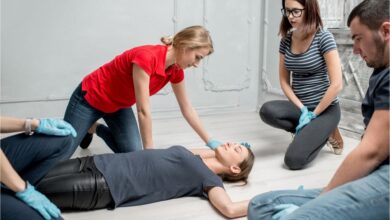Building a Comprehensive First Aid Kit: A Step-by-Step Guide

Emergencies can happen unexpectedly, making it crucial to have a well-equipped first aid kit readily available. Whether at home, in your car, or during outdoor activities, a properly stocked first aid kit can make a significant difference in providing immediate care. In this step-by-step guide, we will walk you through creating a comprehensive first aid kit to ensure you are prepared for various situations.
Empower your team with in-house first aid training. Our programs cover vital skills, fostering a safe and responsive workplace. Equip your staff for any unforeseen medical situation.
1. Choose the Right Container
Selecting the appropriate container is the first step in building a functional first aid kit. Opt for a durable, waterproof container with multiple compartments to keep supplies organized and easily accessible. Consider a clear container to quickly identify and locate items in times of urgency.
2. Essential First Aid Supplies
Ensure your first aid kit includes the following basic supplies:
- Bandages and Dressings: Assorted sizes of adhesive bandages, sterile gauze pads, and adhesive tape for wound care.
- Antiseptic Wipes and Ointments: Cleaning wipes and antiseptic ointment to prevent infection in cuts and wounds.
- Scissors and Tweezers: Sharp scissors for cutting bandages and tweezers for removing splinters or debris.
- Pain Relievers: Include over-the-counter pain relievers such as acetaminophen or ibuprofen.
3. Personal Medications
If you or your family members have specific medical conditions, ensure the first aid kit contains necessary personal medications. This could include prescription medications, inhalers, or epinephrine auto-injectors for severe allergies.
4. First Aid Tools
Include essential tools for providing first aid:
- CPR Mask: A compact CPR mask for safe and sanitary mouth-to-mouth resuscitation.
- Instant Cold Packs: Useful for reducing swelling and inflammation in case of injuries.
- Latex-Free Gloves: Disposable gloves to protect both the responder and the patient.
5. Emergency Contact Information
Print and include a list of emergency contact numbers, including local emergency services, family members, and healthcare providers. Also, add any relevant medical information for quick reference.
6. Specialized Items for Outdoor Activities
If you frequently engage in outdoor activities, consider adding specific items like insect repellent, sunscreen, and blister treatment to your first aid kit. Tailor your kit to suit the unique needs of your lifestyle.
7. Regular Check and Restocking
Regularly check the contents of your first aid kit to ensure that supplies are not expired and that all items are in good condition. Restock any items that have been used or are approaching their expiration date.
Building a comprehensive first aid kit is a proactive step towards ensuring your readiness for unexpected situations. Customizing your kit based on your lifestyle and regularly maintaining it will guarantee that you are well-prepared to handle a range of emergencies. Remember, a well-prepared first aid kit can be a lifesaver in critical moments.



